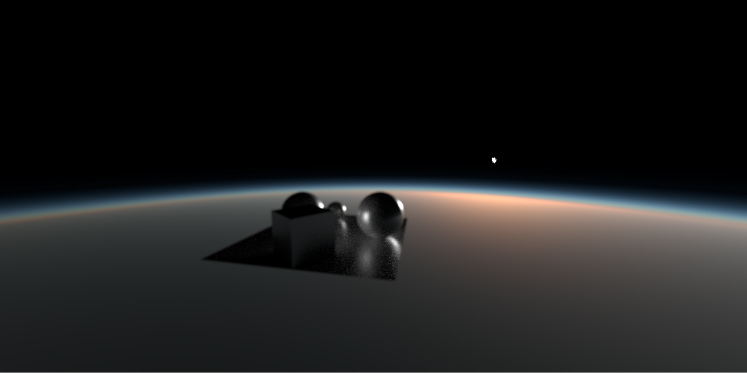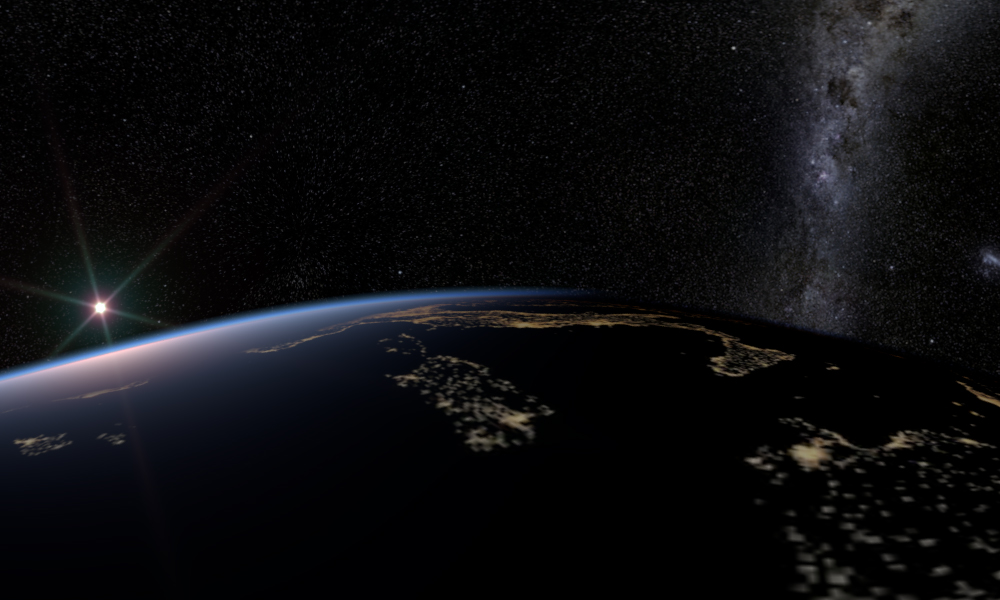
This environment type is a flexible Nishita Sky model. It is most useful when rendering scenes as they are seen from outer space. For its effects to be visible, the camera has to have a very high altitude as it moves out into outer space to view the expansive horizon of the planetary body.
It takes into account the conditions within and beyond the atmosphere of a planetary body (e.g. planet earth) and its surroundings in space. Instead of a single ground color and a sky/sunset color, there is a planetary surface that reflects and emits light. Most importantly, this node serves to extend the environment's medium (volume rendering and subsurface scattering) with an atmospheric scattering through the planetary body's atmosphere. This atmospheric scattering is based on the Nishita Sky Model, a physically based model which displays the variations of color which are optical effects caused by the particles in the atmosphere.
This environment is not connected to the camera and this allows you to zoom the camera view of the objects in the scene in and out while not affecting the position of the environment in the scene. It is a physically based model so it gathers optical depth (transmittance) from the sun position, if the sun position is greater than 0.0f on y axis (upward direction), then it will be colored. If you put it below horizon (i.e. sun position less than 0.0f on the Y axis) then it won't gather transmittance so it will be invisible.

Figure 1: Image rendered using the Planetary Environment where the camera is set at a very high altitude.
Latitude/Longitude - These parameters can be set to get realistic sun settings for the specified geographic location.
Month/Day/Local Time/GMT Offset - These parameters can be used to accurately place the sun in the sky according to the date / time for the sun at the current longitude / latitude.
Sky Turbidity - The Turbidity can be used to adjust the sharpness of the sun lights shadows. A low value creates sharp shadows (like on a sunny day) and a higher value diffuses the shadows similarly to a cloudy day.
Power - The Power slider can be used to adjust the strength of the light. This can affect overall contrast and exposure level of the image.
Sun Intensity - Scale Factor that is applied only to the sun. Used to adjust the relative power of the sun compared to the sky.
North Offset - The North offset slider can be used to adjust the actual North direction of the scene. This is useful for Architecture Visualization to ensure the direction of the sun is accurate to the scene.
Sun Size - This allows users to control the sun radius in the daylight environment.
Altitude - The camera's altitude. Set this to a very high value in order to view the expansive horizon of the planetary body.
Star Field - Texture that conveys star fields behind the planet.
Importance Sampling - This toggles the importance sampling of the sky texture – similar to the importance sampling in the texture environment.
Medium - This parameter can accept an AbsorptionDefines how fast light is absorbed while passing through a medium., ScatteringDefines how fast light gets scattered when traveling through the medium., or Volume medium node to create volume/fog effects across the scene. More information can be found in the Volume Fog Effects article under the Effects Overview category.
Medium Radius - Adjusts the scale of the medium.
Latitude - The latitude coordinate of the camera's current position.
Longitude - The longitude coordinate of the camera's current position.
Planetary Surface
Backplate - This makes the Visible environment behave as a background plate.
Reflections - Makes the Visible environment visible in material reflections.
Refractions - Makes the Visible environment visible in the material refractions.

Figure 2: Image rendered using the Planetary Environment with a star field.